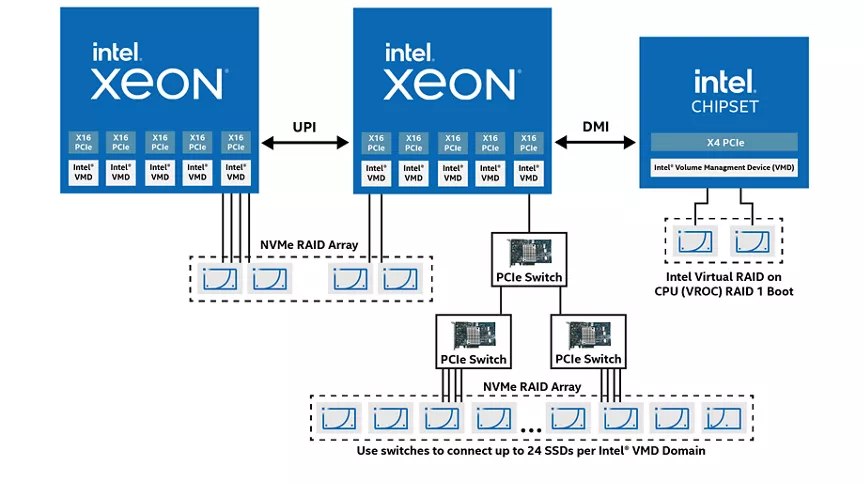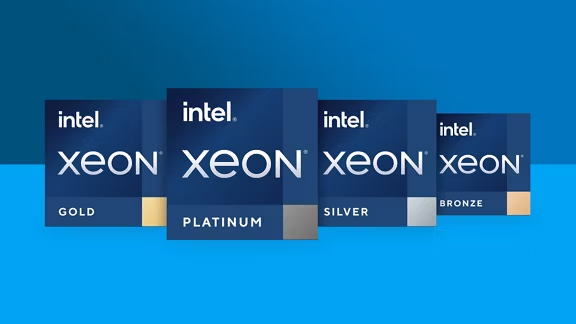Intel® Virtual RAID on CPU (Intel® VROC)
Intel® VROC is an enterprise RAID solution that unleashes the performance of NVMe SSDs, enabled by a feature in Intel® Xeon®Scalable processors called Intel® Volume Management Device (Intel® VMD), an integrated controller inside the CPU PCIe root complex. Intel® VROC enables these benefits without the complexity, cost, and power consumption of traditional hardware RAID host bus adapter (HBA) cards placed between the drives and the CPU.
Intel® Virtual RAID on CPU (Intel® VROC)
Intel® VROC is an enterprise RAID solution that unleashes the performance of NVMe SSDs, enabled by a feature in Intel® Xeon®Scalable processors called Intel® Volume Management Device (Intel® VMD), an integrated controller inside the CPU PCIe root complex. Intel® VROC enables these benefits without the complexity, cost, and power consumption of traditional hardware RAID host bus adapter (HBA) cards placed between the drives and the CPU.
Intel® VROC: Simple, Powerful Data Protection; No Compromises

Comprehensive RAID Support: Boot and data protection with RAID 0, 1, 5, and 10 configurations
Flexible Scalability: Easily expand to multiple NVMe and SATA drives and RAID arrays
Direct-to-CPU Performance: SSDs connect directly to the CPU for maximum bandwidth and speed
Streamlined Architecture: Eliminates the need for a separate RAID card, reducing complexity and cost
Integrated Platform Control: Intel® VMD enables seamless management and monitoring of storage devices
Efficient & Reliable: Lower power use, minimal CPU overhead, and simplified system maintenance.

Powered by Intel® Xeon® Processors
As processing power continues to scale, high-bandwidth access to low-latency storage is critical to realizing the true potential of the CPU. Intel® VMD and Intel® VROC are features of Intel® Xeon® processors that enable a seamless transition to fast NVMe storage to maximize CPU access to data, without a disruption in storage functionality.

Powered by Intel® Xeon® Processors
As processing power continues to scale, high-bandwidth access to low-latency storage is critical to realizing the true potential of the CPU. Intel® VMD and Intel® VROC are features of Intel® Xeon® processors that enable a seamless transition to fast NVMe storage to maximize CPU access to data, without a disruption in storage functionality.
Intel® VROC compared to RAID HBA
45%
31%
49%
69%
Performance Highlights
Intel® VROC is an integrated RAID solution that scales with NVMe SSDs to deliver extraordinary performance, over 6.4M IOPS. Intel® VROC performance is consistently better than RAID HBA, delivering up to 165% more IOPS, up to 62% lower latency and up to 155% better power efficiency.1
Performance Highlights
Intel® VROC is an integrated RAID solution that scales with NVMe SSDs to deliver extraordinary performance, over 6.4M IOPS. Intel® VROC performance is consistently better than RAID HBA, delivering up to 165% more IOPS, up to 62% lower latency and up to 155% better power efficiency.1
Intel® VROC Licensing Options
Standard
Premium
RAID1
Success Stories
How to Buy
Intel® VROC is a licensed product available on certain Intel® Xeon® processors. Product functionality must be enabled by server system vendors. Please contact your vendor for purchasing details. Licensing implementations and options may vary.
Standard: RAID 0/1/10
Premium: RAID 0/1/5/10
RAID1 Only: RAID1
- Cisco
- H3C
- Fujitsu
Supported Configurations
Intel® Virtual RAID on CPU supports several SSD and system configurations. This information covers what the Intel® VROC software can support. Platform level constraints may supersede the information below.
CentOS*
Red Hat Enterprise Linux
SUSE Linux Enterprise Server
Ubuntu
Windows 10
Windows Server
VMware (Intel® VMD and RAID1 for boot only)
* CentOS is a community supported OS. CentOS is not a validated distribution for Intel® VROC, but is functionally aligned to RHEL
Intel® Xeon® Scalable processors (Generation 1, 2, 3, 4 and 5)
Intel® Xeon® W processors
Intel® Xeon® D processors
Intel® Xeon® E (No Intel® VMD. Limited functionality supported)
Up to 48 NVMe SSDs per platform (may require switches)
Up to 14 SATA SSDs per Chipset (SATA/sSATA)
24 SSDs per RAID 0/5 array
4 SSDs per RAID10 array
2 SSDs per RAID1 array
Features
Isolate Error Handling
Intel® VMD isolates SSD error and event handlingfrom the operating system to help reduce system crashes and reboots.
Enterprise Reliability
Increased protection from data loss and corruption in various failure scenarios such as unexpected power loss, even when a volume is degraded.
Extended Management Tools
Pre-OS and OS management includes HII, CLI, email alerts, and a Windows GUI, all supporting NVMe and SATA controls.
Boot RAID
Redundancy for OS images directly off the CPU with pre-OS configuration options for platform set-up.
High Performance Storage
Connect NVMe SSDs directly to the CPU for full bandwidth storage connections.
Out-of-Band & SED Management
Remotely retrieve drive inventory, monitor RAID status, and manage array operations while securing data with Self-EncryptingDrives (SEDs).


.png)


